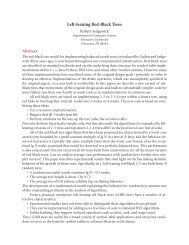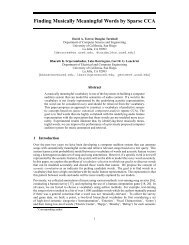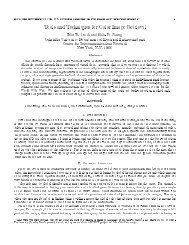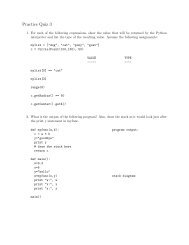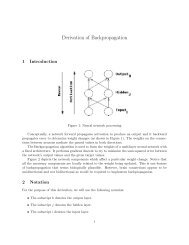Solving Geometric Problems with the Rotating Calipers *
Solving Geometric Problems with the Rotating Calipers *
Solving Geometric Problems with the Rotating Calipers *
You also want an ePaper? Increase the reach of your titles
YUMPU automatically turns print PDFs into web optimized ePapers that Google loves.
p i+1<br />
q j+1<br />
p i+2<br />
4. The Vector Sum of Two Convex Polygons<br />
Consider two convex polygons P and Q. Given a point r = (x r , y r ) ε P and a point s = (x s , y s )<br />
ε Q, <strong>the</strong> vector sum of r and s, denoted by r ⊕ s is a point on <strong>the</strong> plane t = (x r + x s , y r + y s ). The<br />
vector sum of <strong>the</strong> two sets P and Q, denoted as P ⊕ Q is <strong>the</strong> set consisting of all <strong>the</strong> elements obtained<br />
by adding every point in Q to every point in P. Vector sums of polygons and polyhedra have<br />
applications in collision avoidance problems [8]. The following <strong>the</strong>orems make <strong>the</strong> problem computable.<br />
Theorem 4.1: P ⊕ Q is a convex polygon.<br />
Theorem 4.2: P ⊕ Q has no more than 2n vertices.<br />
Theorem 4.3: The vertices of P ⊕ Q are vector sums of <strong>the</strong> vertices of P and Q.<br />
These <strong>the</strong>orems suggest <strong>the</strong> following algorithms for computing P ⊕ Q. First compute p i ⊕<br />
q j , for i, j = 1, 2,..., n to obtain n 2 candidates for <strong>the</strong> vertices of P ⊕ Q. Then apply an O(n log n)<br />
convex hull algorithm to <strong>the</strong> candidates. The total running time of such an algorithm is O(n 2 log n).<br />
We now show that P ⊕ Q can be computed in O(n) time using <strong>the</strong> rotating calipers. Two<br />
vertices p i ε P and q j ε Q that admit parallel lines of support in <strong>the</strong> same direction as illustrated in<br />
Figure 4 will be referred to as a co-podal pair. The following <strong>the</strong>orem allows us to search only copodal<br />
pairs of P and Q in constructing P ⊕ Q.<br />
Theorem 4.4: The vertices of P ⊕ Q are vector sums of co-podal pairs of P and Q.<br />
φ j<br />
θ i<br />
q j<br />
p i<br />
Fig. 4<br />
- 4 -<br />
P<br />
Q



